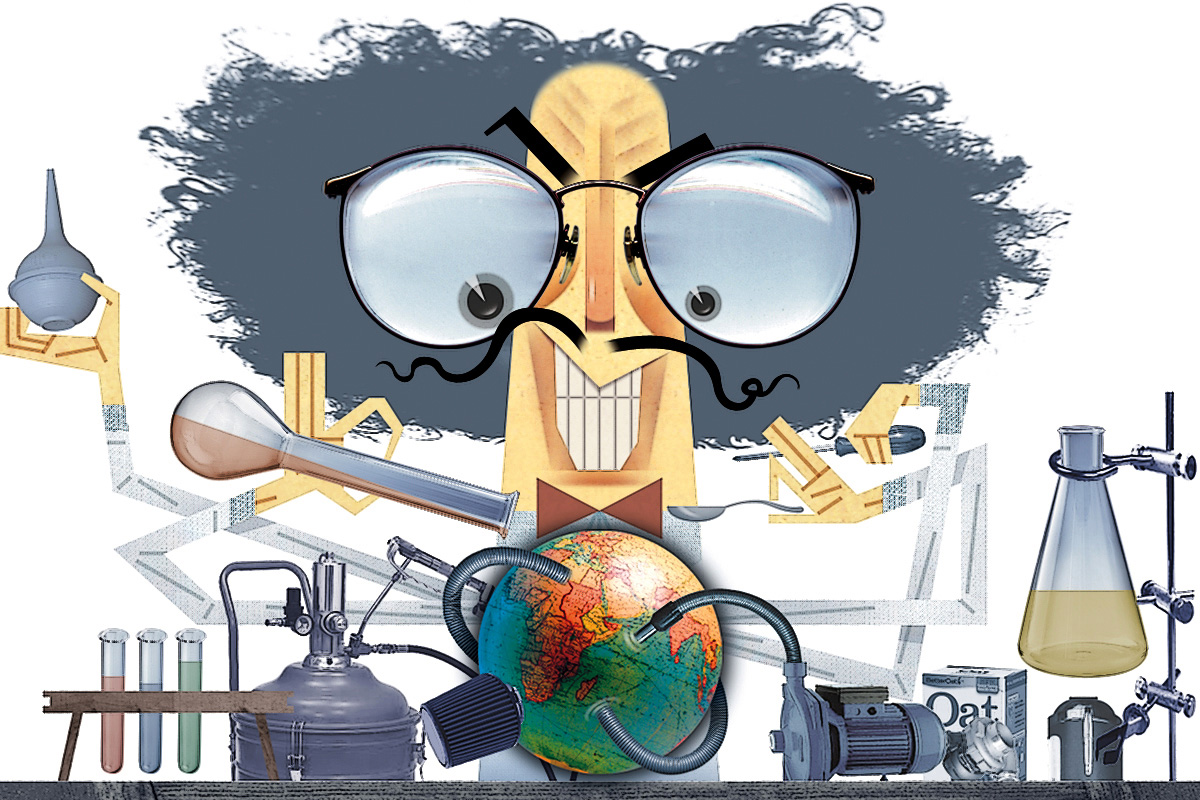
Val Mina
Geoengineering’s time has come — or so a chorus is beginning to swell. Since so far we’ve failed to apply political or economic fixes to the unfolding global warming disaster, a technofix can look — depending on where you sit — like either a slam-dunk no-brainer or a regrettable last resort.
Geoengineering means deploying technology to roll back climate change now that we’ve missed the opportunity to avert it. Schemes come mostly in two flavors: carbon dioxide removal and solar radiation management. In the former, we try to suck carbon dioxide out of the atmosphere and get it back in the ground; or we shunt CO2 aside at the smokestack before it gets to the atmosphere, and bury or store it; or we promote algae blooms that absorb CO2 at the ocean surface and then die off and carry it to the ocean floor. In the latter, we try to deflect solar energy from the Earth by stirring up reflective sea mist or seeding clouds with sulfur particles or doing something else to sunscreen the planet.
In other words: Tamper with the climate even more to deal with the fallout from our climate-tampering! Sounds terribly Rube-Goldbergy — and it is. (If you want more detail, try Grist’s explainer on the subject.) These are large-scale undertakings with large-scale implications for largely opaque systems that we don’t largely grasp.
Unfortunately, the slam-dunkness of geoengineering turns out to be illusory at best. We really don’t know if any of these schemes can or would work. How much time, energy, and money should we put into finding out?
That was the theme of a debate on geoengineering that I moderated last week, and here’s the lesson I took from it: If we expect new technology to save us from the mess old technology has made, but don’t also fix the broken political processes and social dynamics that made it impossible to avert that mess, we’re just inviting a bigger mess.
The debate — an event in Berkeley, Calif., sponsored by Earth Island Journal and Grist, titled “Hack the Sky” — pitted Stanford scientist Ken Caldeira against Australian philosopher/author Clive Hamilton. They’d staked out positions earlier this year in a pair of essays in Earth Island Journal. (The debate wasn’t recorded but here’s audio of a KALW broadcast with Hamilton and Caldeira that covers much the same ground.)
Both men agree that the climate is in peril and we must move quickly to reduce carbon emissions. But that doesn’t seem to be happening. So is it time to begin serious geoengineering research? That’s where the disagreement kicks in.
Caldeira argues that we should be doing the research now so that when calls for a technofix rise at some moment of future crisis, we can at least know what we’re doing, instead of fumbling blindly. He admits that 15 years ago he thought the idea was “loony” and recognizes the possibility of unintended consequences and unforeseen disasters. But he believes the chance that geoengineering could be a lesser-of-evils for our warming world is worth exploring. He likens it to “chemotherapy for the planet”: Poison is poison, but sometimes you resort to it to cope with something even worse.
Hamilton, in turn, argues that geoengineering research is fraught with dangers of mythic proportions. (He makes the case at length in a short, powerful new book, Earthmasters: The Dawn of the Age of Climate Engineering.) Any research program will quickly develop its own momentum, spurred by the financial interests of funders and backers. Indeed, Hamilton says that a “geoengineering lobby” is already hatching. Meanwhile, the more resources we sink into such Promethean research, the more likely the resulting “moral hazard”: People will stop contemplating difficult choices to reduce carbon emissions if they think technology will make the pesky problem vanish.
Most important of all, we have no system or precedent for managing decisions about policies that affect the planetary climate. Of course: That’s why we have a global warming problem in the first place!
My instinctive rationalism wants to side with Caldeira here: Surely more knowledge is better than less. But my pragmatic skepticism tells me that Hamilton’s right. The most likely scenario is that we will screw everything up, colossally. Why go looking to screw up on an ever larger scale?
The pressure to get serious about geoengineering — still a fringe vision, for now — is only going to grow. Over the weekend, The New Yorker posted a grim piece by Nicholas Thompson acknowledging the 400-parts-per-million CO2 milestone we’ve just passed.
On the urgency of geoengineering research, Thompson sides with Caldeira. “We’ve failed collectively,” he writes. Politics and personal sacrifices aren’t going to save us. “Ultimately, we have to invent our way out”:
Everything we use that emits carbon dioxide needs to be replaced with something that doesn’t, whether a car or a cooking stove. Many people are working toward this goal. Many more need to. And then there’s the dangerous, fraught, and potentially essential prospect of geoengineering. Can we suck carbon dioxide or methane down from the atmosphere? Can we shoot something up there that reduces the temperature? Every option is dangerous and complicated. But every option should be studied and tested.
A survey of geoengineering research in a piece by Michael Specter in The New Yorker last year introduced the chemotherapy analogy to me. But a different image in that article was what I remembered as we covered this ground in Berkeley:
Many people see geoengineering as a false solution to an existential crisis — akin to encouraging a heart-attack patient to avoid exercise and continue to gobble fatty food while simply doubling his dose of Lipitor.
Hamilton’s Earthmasters book quotes Lawrence Livermore Labs scientist Lowell Wood: “We’ve engineered every other environment we live in — why not the planet?”
If the hubris there is too much for you, Hamilton balances it with a line from another scientist, Ron Prinn: “How can you engineer a system you don’t understand?”
A great question. I wish my mind didn’t immediately fire off a cynical That’s never stopped us before!




